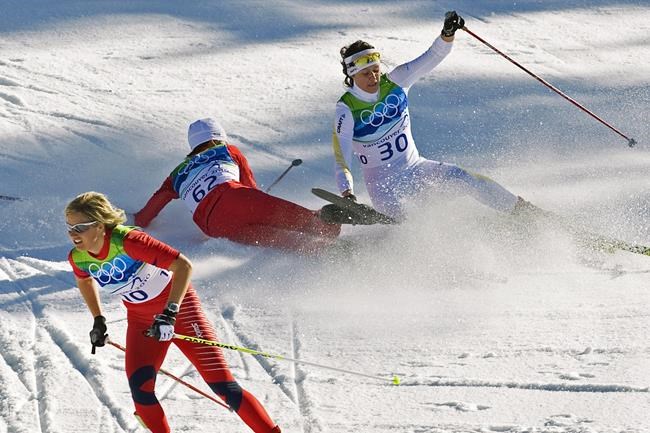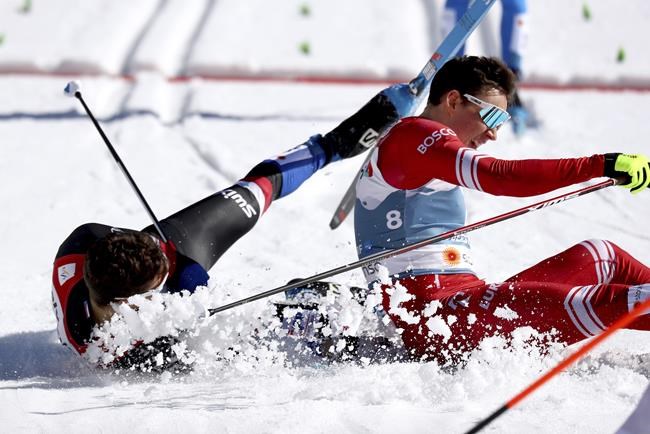Climate change: Athletes flag the dangers of manmade snow
Advertisement
Read this article for free:
or
Already have an account? Log in here »
To continue reading, please subscribe:
Monthly Digital Subscription
$0 for the first 4 weeks*
- Enjoy unlimited reading on winnipegfreepress.com
- Read the E-Edition, our digital replica newspaper
- Access News Break, our award-winning app
- Play interactive puzzles
*No charge for 4 weeks then price increases to the regular rate of $19.00 plus GST every four weeks. Offer available to new and qualified returning subscribers only. Cancel any time.
Monthly Digital Subscription
$4.75/week*
- Enjoy unlimited reading on winnipegfreepress.com
- Read the E-Edition, our digital replica newspaper
- Access News Break, our award-winning app
- Play interactive puzzles
*Billed as $19 plus GST every four weeks. Cancel any time.
To continue reading, please subscribe:
Add Free Press access to your Brandon Sun subscription for only an additional
$1 for the first 4 weeks*
*Your next subscription payment will increase by $1.00 and you will be charged $16.99 plus GST for four weeks. After four weeks, your payment will increase to $23.99 plus GST every four weeks.
Read unlimited articles for free today:
or
Already have an account? Log in here »
Hey there, time traveller!
This article was published 11/01/2022 (1434 days ago), so information in it may no longer be current.
A British skier crashes through wooden fencing on a downhill corner and slams into a pole, breaking his leg. An American hits an icy patch at the bottom of a hill and crashes into a fence, breaking one ski and twisting the other, also breaking his leg.
Another American, training before a biathlon race, slides out on an icy corner and flies off the trail into a tree, breaking ribs and a shoulder blade and punctures a lung.
These were not scenes from high speed Alpine or ski cross events. They happened on cross country ski and biathlon tracks made with artificial snow.

Many top athletes say crashes like these are becoming more common as climate change reduces the availability of natural snow, forcing racers to compete on tracks with the manmade version. Olympic and World Cup race organizers have come to rely on snow-making equipment to create a ribbon of white through the hills since natural snowfall is less reliable.
Johanna Taliharm, an Estonian Olympic biathlete, said racing on manmade snow comes with risks.
“Artificial snow is icier, therefore faster and more dangerous,” she said. “It also hurts more if you fall outside of the course when there is no fluffy snowbank, but a rocky and muddy hard ground.”
Manmade snow has a higher moisture content, making it ice up quickly, skiers and experts say.
“It can be really rock hard out there and falling can feel like falling on concrete, and so it does make it a little bit more dangerous than if it was natural snow conditions,” said Chris Grover, head cross country coach for the U.S. Ski Team.
Some venues even make snow and then store it under wood chips through the summer and spread it around a track when it gets cold. Artificial snow, welcome as it may be, does not get better with age. Race organizers should take that into consideration when designing courses, skiers and experts say.
“It’s pretty universally recognized that courses are firmer and faster than before,” said Gus Schumacher, a member of the U.S. cross country team.
John Aalberg, a former Olympic cross country skier who designs Olympic Nordic ski courses, including for the Beijing Games, said they always consider icy conditions when designing a course. He said a bigger safety issue was the change in race formats from individual starts to mass starts.
“When you ski one-by-one like they used to do in the ’90s, you could have gnarlier downhills and corners because they came one at a time,” he said.
Unlike Alpine equipment, cross county skis don’t have metal edges. They’re designed to be thin and lightweight for climbing hills and gliding over flats. The boots are flexible and connect to the ski with a single metal bar under the toe. Nordic skiers don’t use the edge of the ski to navigate around a corner. Instead, they take fast baby steps to get around the curve.
All of that is more difficult on manmade snow.
Olympic gold medalist and U.S. Nordic ski team member Jessie Diggins said she has reached 76 kilometers per hour (47 mph) going downhill on manmade snow “and it is scary because most of our race trails are built for natural snow.”
“I think it is getting a little more dangerous and I’ve noticed at the World Cup when it is manmade snow, it is scary because instead of sliding on snow you’re sliding on ice,” added Diggins, the overall World Cup winner for the 2020-21 season. “I think we’re seeing a higher percentage of falls. I feel it is a little more dangerous now.”
The International Ski Federation keeps track of injuries dating to 2006. The FIS Surveillance System was created to “monitor injury patterns and trends” and provide data “for in-depth studies of the causes of injuries.”
The reports track Alpine skiing, freestyle skiing, snowboarding and ski jumping. But there’s no data for injures in Nordic events, which include cross country skiing, biathlon and Nordic combined.

When The Associated Press asked if the organization kept track of crashes in cross country and biathlon races, a FIS spokesman said: “We do track injuries during our races, but we do not make our researches public at the moment.” Asked about the concerns over manmade snow, FIS did not respond.
John Morton, a two-time Olympic biathlete and founder of Morton Trails, a Vermont company that designs ski trails, said there are international standards for Nordic ski races. He recalled attending a conference where they discussed banking turns on fast downhills, but there was resistance from some European officials who said it would make it too easy.
“There’s this constant drive to make it more exciting and more dramatic,” he said. “It’s very clear they want challenging courses, they want to push the athletes to the limits.”
In that context, he said, courses designed for natural snow “may have to be modified now because everything is faster – the skis are faster, the wax is faster.”
Manmade snow “isn’t really snow at all,” said Jim Steenburgh, professor of atmospheric sciences at the University of Utah. “What it is is water that’s blown through nozzles that break up the water into extremely small and tiny droplets that then freeze.”
Manmade snow has a higher water content so it has a high density and tends to be really durable, making it good for ski racing, at least for Alpine ski racing, Steenburgh said. But maybe not for Nordic athletes.
British skier Andrew Young was on the fourth lap of a 15-kilometer mass start cross country ski race in Sweden in January when he crashed on the downhill and went through a fence, breaking his leg. It ended his hopes for the 2021 world championships.
Young said climate change has “definitely changed” cross country skiing. He also noted that race courses are shorter partly due to limited snow, but also to bring the skiers through the arena more often for the spectators and television cameras.
As Young put it: “Shorter loops mean more corners, which means more crashes.”
___
More AP Winter Olympics: https://apnews.com/hub/winter-olympics and https://twitter.com/AP_Sports












